
Well, we’re moving right along through August! I’m hoping to get at least caught up to the proper month before September ends…and I’m behind again. We’ll see if I can manage, but so far, so good. In this post we have two interesting stories, and I’ve been rather looking forward to this one. Be warned, I’m going to indulge my professional interest a bit with some philosophical and literary reflections about the second issue!
Roll Call (You can see everything published this month HERE)
- Action Comics #391
- Aquaman #52
- Batman #224
- Teen Titans #28
- Detective Comics #402
- The Flash #199
- Justice League #82
- Phantom Stranger #8
- Showcase #92
- Superman #229
- World’s Finest #195
Bolded entries are covered in this post, the others will be covered soon.
Justice League #82
 “Peril of the Paired Planets”
“Peril of the Paired Planets”
Writer: Dennis O’Neil
Penciler: Dick Dillin
Inker: Joe Giella
Cover Artist: Neal Adams
I enjoyed this story much more than I expected to. At first blush, I rather thought it was going to be on the goofy side, and it does have its moments. Nonetheless, the final effect is fairly enjoyable. O’Neil’s run, though not completely stellar, continues to be strong overall. In this issue, as with the Jestmaster, we once again get a promising concept that doesn’t have quite the right execution. The villains of the piece are a race of aliens lead by a fellow named Creator² who build planets for a living, destroying existing ones to create the energy for the construction. Anyone else reminded of Hitchhiker’s Guide to the Galaxy? That’s right, the bad guy is Slartibartfast. The stakes, complete planetary annihilation of not one, but TWO Earths, are certainly worthy of the Justice League, and the idea of an alien race that creates new planets by destroying old ones is the kind of thing that could totally work in the DC Universe. Unfortunately, the aliens are rather goofy looking, and the concept just doesn’t entirely come together. Another pass might do wonders.
As is, our tale begins with a very strange occurrence as Superman plummets from the sky, seemingly immobile and unconscious. The League brings him to the Satellite, but they can find no explanation for his sudden illness. Then, Batman suddenly falls victim to a similar phantom ailment and passes out. The Leaguers (Flash, Atom, and Hawkman) call their missing members (Green Arrow, Green Lantern, and Black Canary, sadly, no mention of Aquaman…), hoping against hope that one of them will be able to solve this mystery. I’m going to have to go ahead and call shenanigans on O’Neil for this. If you’ve got your favorite characters out on walkabout in GA/GL, then you can’t just pull them in for every JLA issue. It sort of wrecks the whole, ‘on hiatus’ thing. Why not give some other characters more of a chance to shine if you’re so dedicated to the oddball story you’re telling with them?
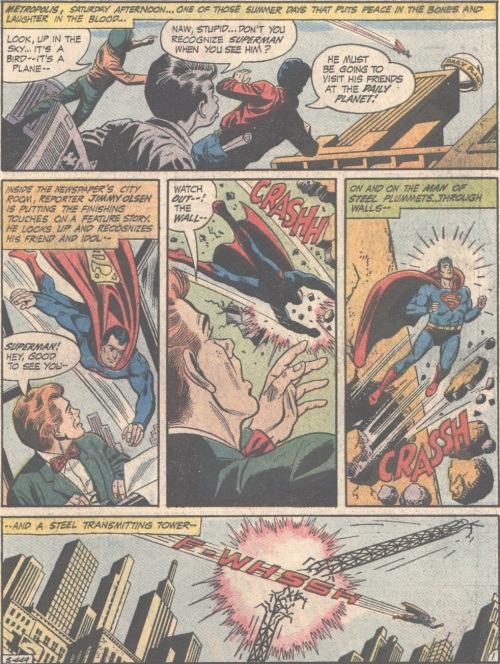
Anyway, we then discover what is going on through a flashback that takes us to Earth 2! That’s right, we’re seeing a JLA/JSA crossover starting in this issue, and that is pretty exciting. I love the concept of these events, even if the execution wasn’t always fantastic (a common trait with the JLA, unfortunately). While I prefer my JSA as the Earth-1, WWII predecessors of the League, there is something undeniably fun about having the two sets of heroes being able to hang out from time to time. I even told a time travel story in my second JLA campaign in the DCUG, just so I could bring all of these heroes together, with the rosters cleaned up for continuity purposes, of course. There’s no need to have multiples of the same character running around. I always hated it when we got two Supermen or two Batmen, after all, as that just felt like a gyp. I already get to read about those guys!

I seem to have dragged myself off track. Ahem. Anyway…again…in the space between the two universes, Supreme Leader Snoke, err, I mean the Creator², captures poor, lonely, unloved Red Tornado, who is flying around empty, airless, as in no-freaking-wind, space…somehow. This is one of the minor slips that hurt this issue. It isn’t a huge deal, but come on. Tornado’s whole thing is that he moves air around. How the heck is he flying or doing much of anything where there is no air to move?
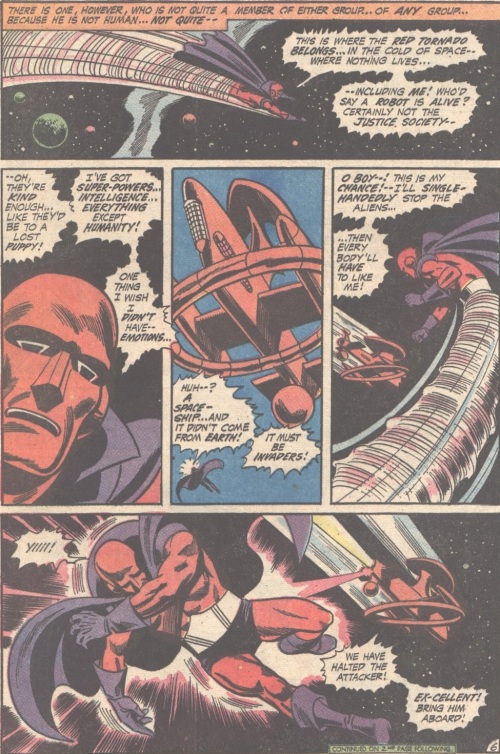
The much bigger misstep is Reddy’s dialog and general characterization in this section.
The android is moping around space feeling sorry for himself, lamenting that he doesn’t fit in, even with the JSA. When he sees the aliens’ ship approaching, the Tornado says, “Oh boy, this is my chance! I’ll single-handedly stop the aliens…then everybody’ll have to like me!” Ouch. That feels like something that would show up in one of my worst comp. papers. While it becomes a fixture that Reddy is a melancholy machine, this is just ham-handed and hokey. Unfortunately, this type of one-dimensional, excessively melodramatic characterization is going to become indicative of the maudlin mechanical man. He’s as emo as Kylo Ren! This is part of the reason that poor Reddy has never achieved the popularity and gravitas of his Marvel counterpart, the Vision, despite having all of the same potential. It’s a real shame, because he really is a great character. I suppose that, given my love of underdogs, it is to be expected that I rather like this second-rate Leaguer who, at least for most of his history, never quite found his niche. We’ll be seeing more from him in the future, of course, as he’ll soon be joining the team.
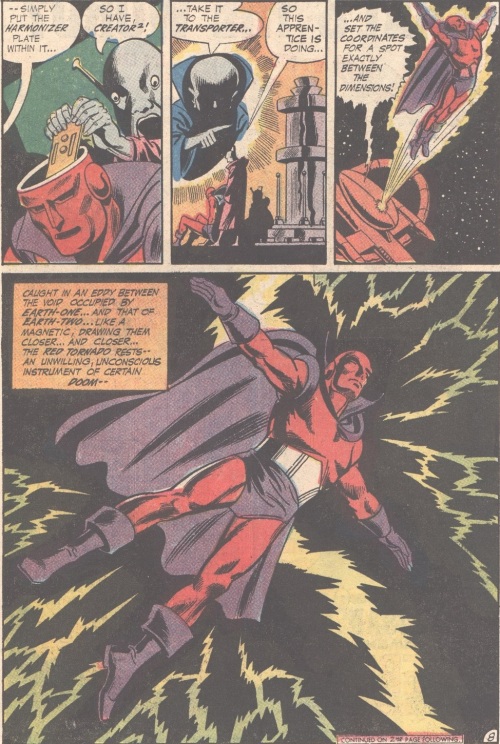
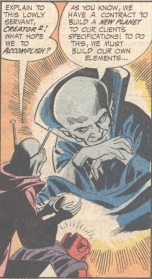 Reddy, of course, fails miserably in his efforts, because for some reason JLA writers decided to make him the team’s whipping boy. Did Super Schlub grow up to be Red Tornado, or what? The afflicted android is captured, and belonging to both Earths, he is able to be used as the focal point for the evil machinations of the planet-wreckers. Power flows through the captive hero, and the two worlds begin to close in on one another, the barriers between them weakening. Meanwhile, the aliens launch a preemptive strike on the JSA to prevent their interference.
Reddy, of course, fails miserably in his efforts, because for some reason JLA writers decided to make him the team’s whipping boy. Did Super Schlub grow up to be Red Tornado, or what? The afflicted android is captured, and belonging to both Earths, he is able to be used as the focal point for the evil machinations of the planet-wreckers. Power flows through the captive hero, and the two worlds begin to close in on one another, the barriers between them weakening. Meanwhile, the aliens launch a preemptive strike on the JSA to prevent their interference.
Creator² arms his assistants with special nets that can counter the heroes’ abilities and dispatches them to capture the champions of Earth 2. Now, I rather expected this to be goofy and cheesy after the awkwardness of the opening sequence, but the action is actually well-staged and believable in context. Superman is easily captured because he doesn’t bother to dodge. Why should he? That’s a good touch, and it makes sense. In the same way, it is actually Dr. Mid-Nite that causes the acolytes some trouble, as he’s more wary. It’s also worth noting that the heroes, not knowing if these aliens are hostile or friendly, don’t just come out swinging. That’s a good spot of characterization for the team. Unfortunately, their beneficence leads to their defeat.
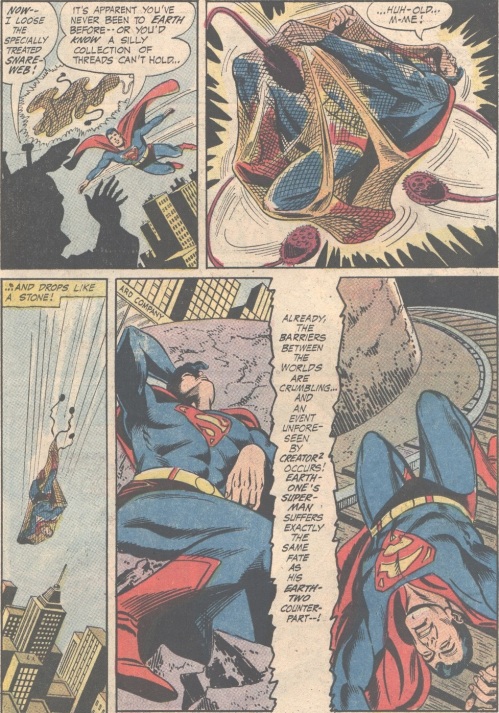
It is these events that explain the strange ailments of the Earth-1 heroes. As the JSA members were incapacitated, the weakened barriers allowed the effects to bleed over into the their closest counterparts among the Leaguers. I’ll buy that. It makes sense, in a comic kind of way. I do have one bone to pick, though, and that’s the fact that Batman is identified as the closest counterpart to Mid-Nite, but we see the Earth-2 Batman just a few pages later! Shenanigans I say! Well, fuzzy logic aside, the Flash arrives on the scene, and he actually manages to do some good against the invaders, evading their nets with some clever maneuvering and decking one of them, but he is distracted by the sudden appearance of his Earth-1 counterpart! The momentary interruption is all it takes for his foes to capture him as well. This, of course, also causes Barry to be stricken as well.

Suddenly, ghostly images of doppelgangers begin appearing around both worlds as the barriers break down even more. The two teams meet up on their separate Earths and try and make plans, Starman playing the hothead among the JSA. Fittingly, it is the Atom, a physicist, who figures out what is going on. By crunching the numbers, he susses out that the two Earth’s are being pulled together and theorizes that the cause is some being with a connection to both planets. Black Canary tearfully concludes that she must be culprit and insists that she must…die! It’s not a bad moment, and it makes pretty perfect sense from their point of view. It’s a good, tense note to end on, with the two worlds preparing to collide and no-one yet knowing what is behind it.
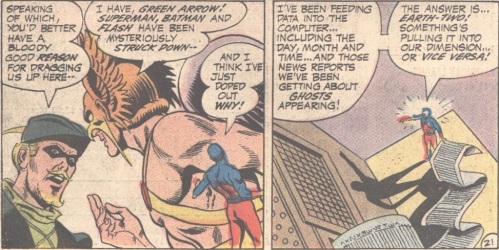
- I suppose it’s…good…that O’Neil is at least being consistent with his insufferable characterization of Green Arrow? ‘No Ollie, there’s no emergency, I just thought it would be fun to interrupt your road trip’
This is a good issue, a fun enough adventure, though it is really a bit more of a JSA story than a Justice League one. I’m entirely okay with that, as I love both groups. As I said, the threat is certainly big enough to serve as a fitting challenge for these two massively powerful teams, though the aliens are really too goofy and boring looking to be entirely successful as antagonists. The callous disregard their master, this Creator fellow, has for the life on these two worlds is a good trait for a cosmic villain, but I wouldn’t have minded learning a bit more about him.
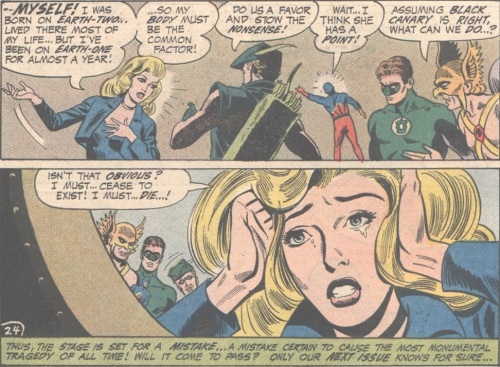
The fairly abominable writing of Red Tornado is a bit of a black mark on the issue, but it’s still a relatively minor part of the tale. Unfortunately, Dick Dillin’s art isn’t quite up to snuff in this story. He has some nice panels, but there’s also a lot of awkward, stiff figures (like the Superman sequence in the beginning) and art that just seems a bit ‘off.’ So, in the end, this is an enjoyable but flawed book. It’s great fun to see the JSA and the JLA working on two sides of the same problem, but the weak points in the story and the weaker art keep the comic from being as good as it might. I’ll give it 3.5 Minutemen.

Interestingly, the letter pages are filled with praises for JLA #78 and 79, the pollution focused issues. Clearly, the idea of tackling heavier topics was really popular with fans. In fact, one epistler writes in to say that major newspapers were reporting on these comics. Notably, the writer also opined that his own city had a major problem with pollution. Apparently, not-yet-disgraced President Nixon had just given a State of the Union address that named pollution as one of the major problems facing the nation. Neat! Those stories were obviously much more timely than I realized.
Phantom Stranger #8
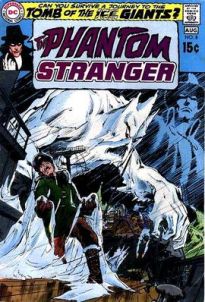 “Journey to the Tomb of the Ice Giants!”
“Journey to the Tomb of the Ice Giants!”
Writer: Dennis O’Neil
Penciler: Jim Aparo
Inker: Jim Aparo
Colourist: Jim Aparo
Letterer: Jim Aparo
Cover Artist: Neal Adams
Man, I’ve been looking forward to this one. Just look at that cover! I’ve seen that sucker waiting for me in my reading list, and I just couldn’t wait to see if the story inside is as awesome as that cover. Don’t worry, you won’t have to suffer in suspense like I did. This issue does, in fact, lives up to the awesomeness of the cover. This is definitely my favorite Phantom Stranger issue so far, and it is here that I believe the series really finds its feet. Even the editor seems to realize that they have hit on something special with this issue and this team. He begins the letter column with a note that O’Neil and Aparo “have taken the Phantom Stranger to new heights” and remarks that he is particularly proud of the issue. This unusual bit of editorial praise is, in my estimation, pretty spot on. This tale really dives into the mystical and even mythical elements inherent in the character’s conceit, and it makes the DC Universe a more fantastic and interesting place in the process. In my estimation, that’s one of the best contributions a book can make. On the art front, Aparo seems to be on the book full time now, and I couldn’t be happier. He’s at the height of his powers, so the comic is beautiful, dynamic, and full of interesting and individual looking characters. Aparo creates no generic faces and no disposable characters. Every figure he draws is unique and striking. I’m afraid I’ve got rather a lot to say about this one, as it quite captured my imagination, resonating with many ideas that have been on my mind lately.

This mysterious and mythic adventure begins in the arctic, with an ice breaker named the S.S. Night Wind suddenly finding itself faced with a vision from nightmare and legend, a massive giant of ice and snow! It’s cold hands close about the ship, and suddenly the vessel is entirely trapped in ice. We’re treated to a lovely two-page spread that shows us the scale of the little drama, and the Stranger briefly appears to the crew of the trapped ship to warn them of their danger.
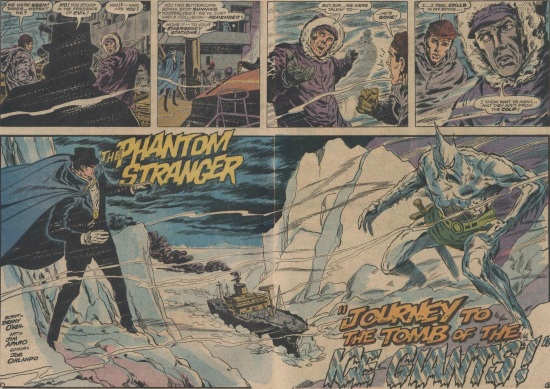
Our scene shifts to Alaska, where the ship’s financier, Mr. Muttson rages over the trouble with the Night Wind. He steps into a steam room to try and warm up, but he suddenly freezes solid! The local law is baffled, as you might imagine, and they call in everyone’s favorite wet blanket, Dr. Thirteen, who was conveniently near-by. I’m willing to hand-wave his deus ex machina appearance because we are dealing with a story in a high dramatic tone and fate (or her Master!) may very well be playing a hand.
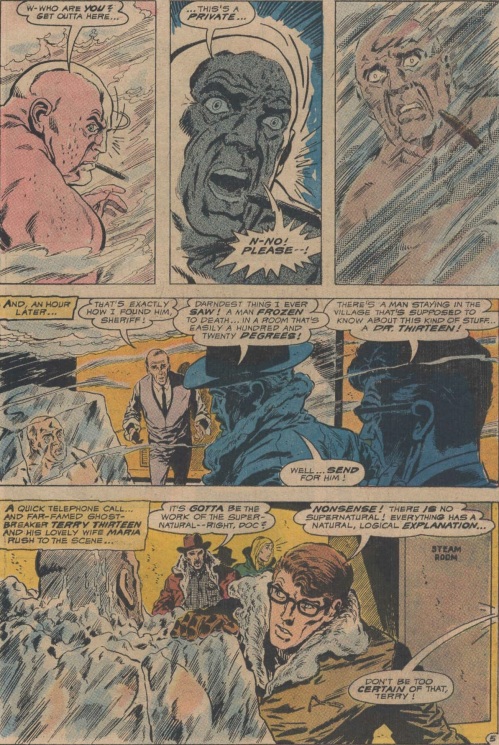
The Stranger once again puts in an appearance to investigate the mystery himself, and we get yet another confrontation between the two characters. Despite how many times we’ve seen its like, this scene is actually quite good. There’s a certain intensity to the good Doctor’s reaction, a certain frustration and anger that rings true and rises above just rote repetition. Thirteen is his usual charming self in this issue, and yet there is something more interesting and sympathetic about him that I can’t quite entirely put my finger on. In this exchange, we even get a funny little note that made me chuckle. The mysterious Stranger greets his opposite number as “Terry,” and this immediately gets under the skeptic’s skin, so much so that you have to think he intended it to do so. Either way, Thirteen responds that “if he calls me Terry again, I’ll bust him–so help me-.” It’s a good character moment, adding a bit more personality to the occult investigator than just stiff-necked skepticism. After all, he’s got to be getting sick of having the Stranger show him up.
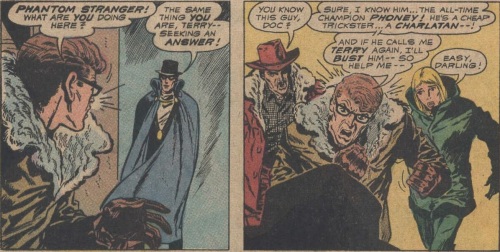
The Phantom disappears, of course, and, also, of course, the Doc dismisses any possibility of the supernatural in that, or in this strange frozen death. The case reminds him of another, as they all seem to, and he begins to relate the story, telling his listeners about the time a wealthy recluse was found frozen to death in the hothouse in which he kept his prize orchids. While both the policeman investigating the death and the victim’s nephew suggest some type of mystical explanation, Thirteen is adamant that nothing of the sort is possible. He finds a canister of freon, and, realizing that the orchids themselves are also frozen, he deduces that the recluse was flash-frozen by someone pumping the chemical in through the sprinkler system in the hothouse. The skeptical sleuth accuses the nephew, and then he proves he is more than just a mind, as he disarms and captures the killer in a nice sequence.
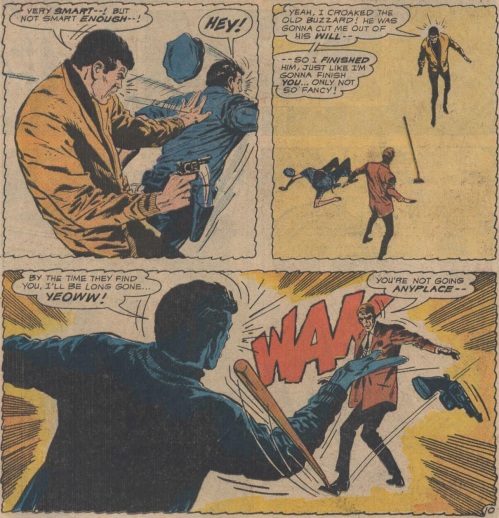

Dr. Thirteen, surprising badass
 That’s actually one of the best interpolated episodes we’ve seen so far, with a good mystery, a solid action beat, and Dr. Thirteen actually portrayed to good effect. He’s much more likable here than we’ve seen previously. Back in the main tale, the local chemist (given a ton of personality in his portrayal by Aparo, despite the fact he appears in a grand total of one panel), discovers that the ice entombing Muttson could only have come from the arctic. Thirteen and his wife, sensing a link, prepare a helicopter to fly out and investigate the icebreaker. Before they depart, the Stranger appears with a dire warning, and the Doc actually take a swing at him!
That’s actually one of the best interpolated episodes we’ve seen so far, with a good mystery, a solid action beat, and Dr. Thirteen actually portrayed to good effect. He’s much more likable here than we’ve seen previously. Back in the main tale, the local chemist (given a ton of personality in his portrayal by Aparo, despite the fact he appears in a grand total of one panel), discovers that the ice entombing Muttson could only have come from the arctic. Thirteen and his wife, sensing a link, prepare a helicopter to fly out and investigate the icebreaker. Before they depart, the Stranger appears with a dire warning, and the Doc actually take a swing at him!

In the vast, empty wastes of the frozen north, the Thirteens find the trapped ship and begin to search for some clues. Suddenly, they spot a flash of reflected light, and they descend to discover a huge sword, fit for…a giant! Just then, the occult investigator is smacked by a giant hand, and both he and his wife are seized by a towering figure that embodies the desolate icy wastes in which he moves. The creature ominously declares that the humans have violated the sleep of his people, a sleep that began at the dawn of time!

Fortunately for ‘Terry,’ the Stranger appears once more, and he demands the giant release the two humans. I love his description of himself. He announces that he “serve[s] a cause — a master — as ancient as” the giants themselves. I quite like that, evocative yet mysterious, fitting easily any of the myriad identities we might assign the character (my favorite is still the Wandering Jew serving God). That’s a difficult line to walk, but O’Neil manages it well here.
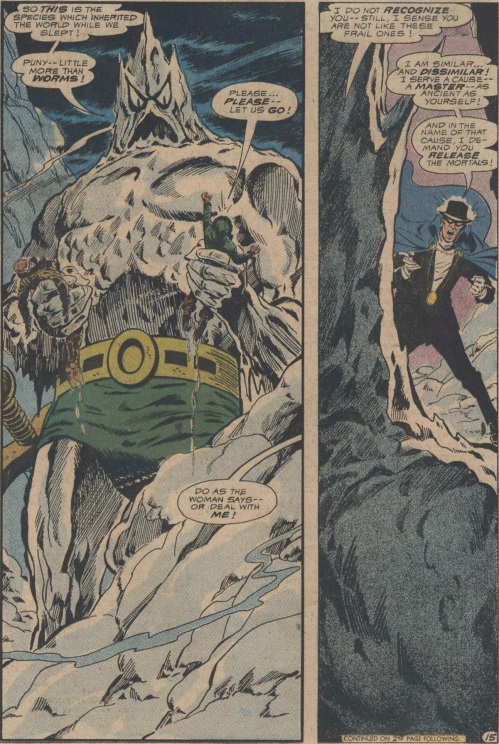
The giants’ design isn’t quite right, what with the green trunks…
Well, as if the situation weren’t tense and chaotic enough, Tala chooses this moment to arrive. She is her usual delightful self, and I really love her portrayal in this issue. She is becoming a more fully realized character, while still remaining disconcertingly mysterious. She makes her usual play for the Stranger, trying to persuade him to join her and abandon the mere mortals to their fate, but this time it is less about an archetypal contest between light and dark and more about the character herself. O’Neil is really firing on all cylinders in this exchange. Tala kisses her rival, and he pushes her away, proclaiming “death lies in your kiss!” Her response is excellent, “Indeed, but such a death as can pale life.” That’s almost poetic, and it fits the higher tone of the piece, what with its ancient civilizations and apocalyptic possibilities.
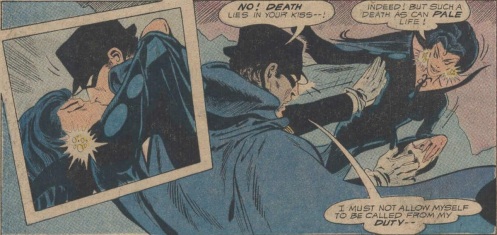
Right after that we hit a rather weird note, as the Stranger stands forth to oppose the giant, employing his vast and enigmatic powers…no, wait, he punches the titan in the face. Okay…it is extremely cool looking, and I have no problem with the supernatural sleuth getting his hands dirty once in awhile. Still, we’ve seen him employ some pretty impressive powers in the previous issues, so it is rather jarring for him to suddenly act like all he’s got in his bag is a good right hook. If O’Neil wanted to limit him, all he needed was a line of dialog, something like ‘I can’t use my abilities because it would awaken the magic of the giants,’ or SOMETHING. Instead, the hero is smacked down, quite literally, and seems helpless against the jotunn-like creatures.
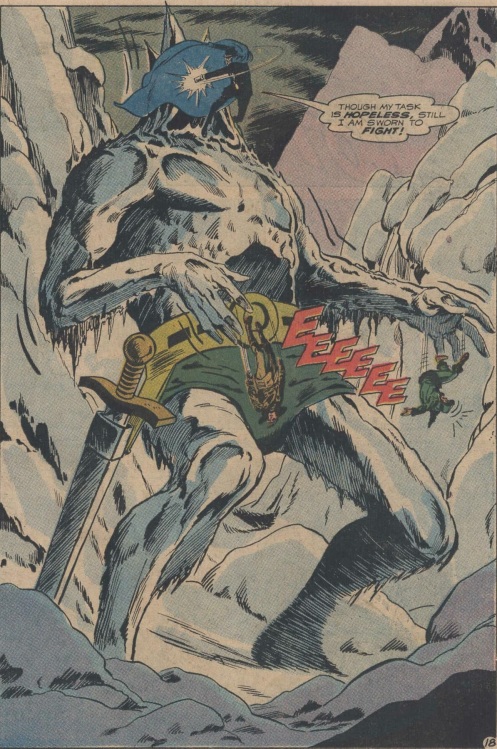
You have to admit, though, it’s a heck of a page.
They announce their plans to emerge from their self-imposed exile and reclaim the Earth, but the Stranger, in a wonderful two-page spread, warns them that this globe is not what it used to be. Humans have sort of wrecked the joint, as we are wont to do. Here we see some more of O’Neil’s use of realistic and weighty themes, dealing with the social unrest and the pollution that we’ve seen influencing the books we’ve covered. It’s a nice sequence, not too heavy-handed or preachy because of its context and the solid prose that he marshals for the effort.

The giants are swayed, but their laws still demand a sacrifice before they can return to their centuries-long slumber. Tala helpfully suggests they take Maria Thirteen, and in a flash of light, she seems to render her helpless. Unopposed, the frozen fiends return to their glacial home, and here we reach the second odd moment in the book. The story takes a fairly dark turn all of a sudden, as the Stranger silently watches the titans’ exodus, not lifting a finger to prevent their killing an innocent woman. Then, he carries ‘Terry’ back to his helicopter and once again employs mundane methods in his fight, eschewing his powers. He seals the entrance to the giants’ cavern with dynamite, leaving Maria to her fate.

The Stranger coldly rationalizes his choice, reasoning that her sacrifice was necessary because any contact between giants and men would inevitably destroy both because of the wrack and ruin that a conflict between magic and technology would unleash. This is another fascinating concept that just gets tossed out in this issue, one of many that create a wonderful atmosphere of history and mythology lying behind the plot itself. Yet, the hero’s choice cannot help but seem both unnecessary (without further framing) and callous to us.

Fortunately, after the cave is sealed, who should make her way back to the helicopter but Maria! Tala returns and explains matters, telling her opponent that she, indulging in her chaotic nature, could not resist playing a trick on the giants, and thus took the girl’s place when she caused that blinding flash. It’s a good and rather surprising moment, yet it fits the character well. I like Tala as not just a being of pure evil, but an avatar of chaos, more like Loki than Satan, the Trickster figure brought to life. I think that’s got potential, and it certainly has mythical echoes.

The story ends with the Thirteens reunited and ‘Terry’ being ridiculously condescending to his wife. To her credit, she doesn’t seem to be taking his nonsense entirely meekly. Here again we have the good Doctor blatantly disregarding a reliable eyewitness to the supernatural because “we both know such things simply do not occur!” Great job being scientific and impartial, Terry. This ending really struck me, as I realized that Dr. Thirteen is willfully blind to the higher realities he continually comes in contact with. He has now encountered several mysteries that he’s been entirely unable to solve, yet he persists in his stiff-necked adherence to his world-view. This was particularly interesting to me because I just read C.S. Lewis’s Miracles, his philosophical case for the possibility of the miraculous. One of his arguments touches on the fact that this is how most of us approach any such questions. We know miracles cannot exist, therefore, every other explanation, no matter how ridiculous, must be more probable. This cannot help but bias us in our investigation of such matters, as we have a priori decided that one explanation is impossible. In this dogmatic dedication to disbelief, Dr. Thirteen reminds me very strongly of the dwarves from The Last Battle. I can imagine Thirteen sitting there in the dark with them, seeing a dirty barn while surrounded by the eternal, refusing to acknowledge the reality that was staring him in the face. It makes him something of a tragic figure as well as a comic one and probably has something to do with my growing appreciation for the character.
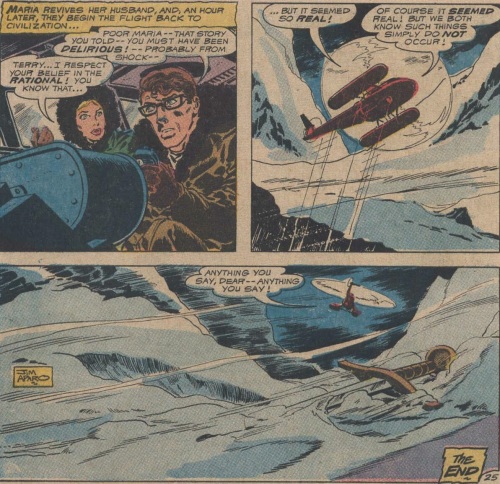
This was a great story, and the complaints I have are minor. The most significant of them is that I wish the concepts tossed out left and right in this book were given more development in the wider lore. Apparently we do see the giants return in a later issue, so that is exciting! It was of particular interest to me because I’ve just been studying the medieval tradition of giants, which the titanic creatures of this tale evokes. I actually just wrote a paper on the giant/Jute debate in Beowulf¹. I love the archetypal weight the figure of the giant carries, the ageless antipathy between man and monster. In the medieval tradition, the giants were identified with an antediluvian (pre-Flood) culture, advanced and wicked, possessing great knowledge and power, but corrupting men with that power and forbidden learning. They were identified with pride (which, if we recall, was the first and greatest sin) and greed.
These jotunn-esq beings with their ancient civilization remind me a bit of those stories. Their implied history and the Stranger’s cryptic statements indicating the existence of a whole hidden lore helps to give this particular story its strongest feature, that most wonderful quality of literature, which Tolkien called “the impression of depth” (Monsters and Critics 27). This is the effect that gives works like The Lord of the Rings such a vastness and feeling of reality. It is the quality that leads a reader to believe that the story does not just exist in these limited pages but expands infinitely on every side of the book itself, with a rich past and undiscovered countries just beyond every hill. This quality is, of course, limited in this instance, and the the comic has its weaknesses, the loose threads in the tapestry O’Neil is weaving. Nonetheless, the final effect is exactly that sense of wonder and imaginative adventure that brings me to comics in the first place. This is the type of story that I love to read, and I give this issue a very strong 4.5 Minutemen.
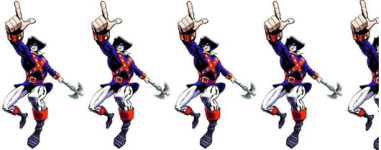
Well my good readers, that is it for this post. This is shaping up to be one heck of a month! We’ve had some great, high-scoring and fascinating issues, and there are more promising stories on the horizon. It definitely looks like we’re facing a much better crop of books this month. I hope you’ll join me soon for the next few issues, which will include the next iteration of Manhunter 2070!
¹If you’re interested in literary studies, philology, or textual criticism, you might find this worth reading. If these things don’t interest you, you can safely skip this section. Several of the incidents in Beowulf feature the word eoten, which means “giant,” even being related (most likely) to the Old Norse word, “jotunn,” which describes the monstrous figures of scandinavian myth. Yet, in several spots editors emend it to mean “Jute,” an ancient people that were often in conflict with the Danes. Essentially, the argument is that a later scribe, having never seen “Eotan,” the word for Jutes, just substituted “eoten,” or “giant.” Coincidentally, this approach to the poem seems to me to be motivated by much the same resistance to the fantastic that drives the close-mindedness of people like Dr. Thirteen. Scholars have desired a historical document from Beowulf, though that was never what it was intended to be. They hope to find mythologized records of actual conflicts, real history behind all the fantasy ‘fluff,’ but you can no more do away with the giants than you can with the dragon. They both lie, not at the periphery, but at the core of the poem. The debate continues (it’s giants), and though there are reasonable arguments for finding Jutes (really, it’s giants), they tend to create as many problems for interpretation (seriously, it’s giants) as they solve. Meanwhile, rendering these mysterious figures as giants creates greater dramatic unity, (trust me, giants) emphasizing many of the primary themes of the main plot, especially the corrupting effects of power and wealth, both associated in medieval tradition with the figure of the giant (it’s totally giants).
I got to know about Marvel & DC comics growing up in England; we had sporadic distribution in those days and I relied on secondhand books anyway – I never had a copy of a Phantom Stanger book at all; that was a real miss, I’m coming to see …
… the Spectre had a run of books, was that pre 1970?
Yeah, my early exposure to comics was through the spinner rack at my local grocery store. What I had access to was always a bit hit or miss, though for smaller scale reasons. It wasn’t until I was older that I could actually follow a series all the way through and such. I hadn’t ever read any of the Stranger’s solo stories until I started this project, but I’ve read a lot about DC history over the years, so I knew something about them to begin with.
The Spectre did indeed have a famous and controversial run in Adventure comics in the 70s, very indicative of the Bronze Age. It was illustrated by Jim Aparo, no less! I’ve read a few of those, and they are pretty out there, but pretty cool. We’ll get to them in 74.